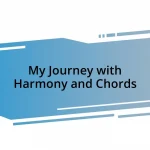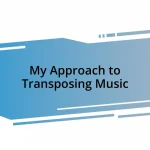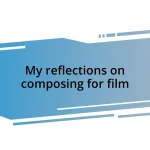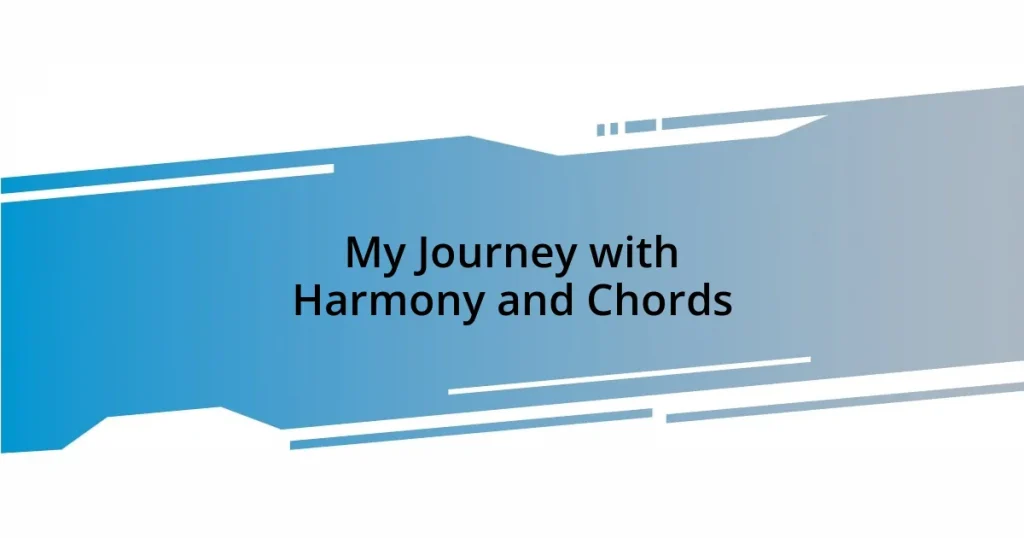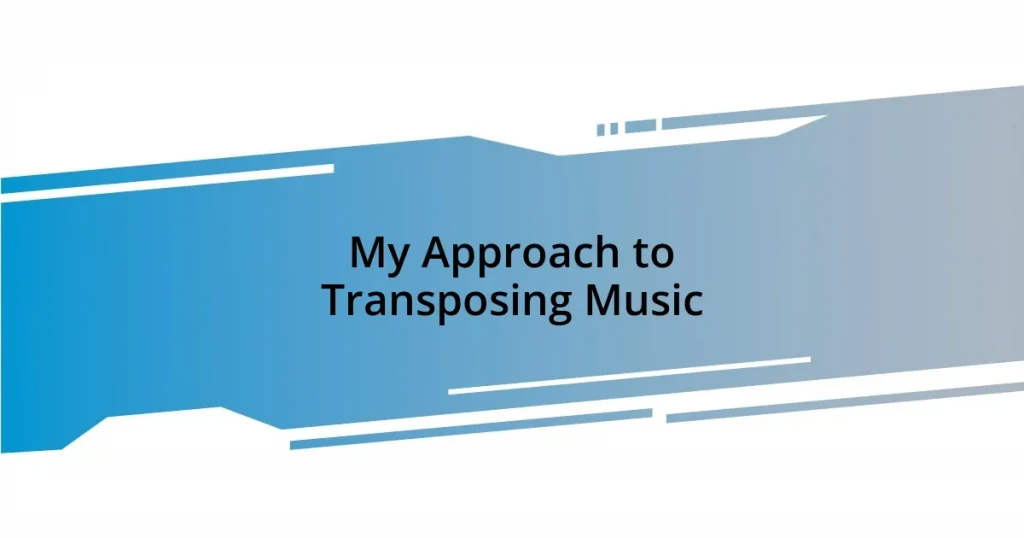Key takeaways:
- The journey of music adaptation involves understanding the emotional core of a piece and the unique characteristics of each instrument.
- Effective adaptation requires deep listening, exploration of instrumental strengths, and creating a dialogue among instruments.
- Challenges in adaptation include technical limitations and the need for collaboration to balance individual artistry within a cohesive arrangement.
- Flexibility and openness to feedback enhance the creative process, allowing for delightful discoveries and improved interpretations.
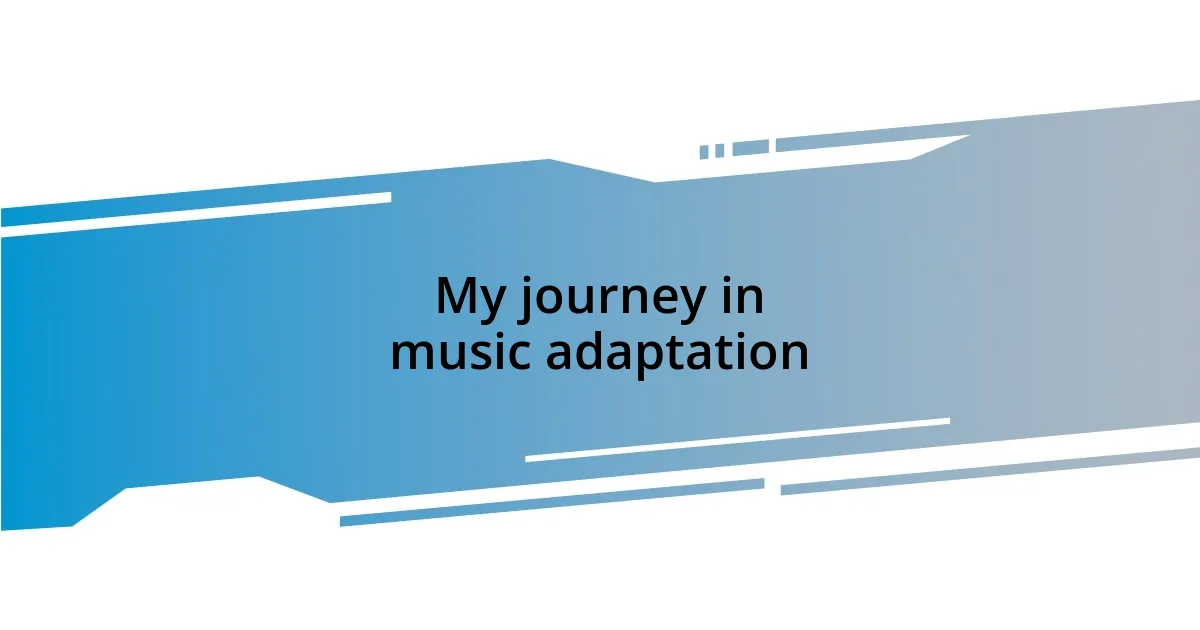
My journey in music adaptation
Adapting music for different instruments has always fascinated me. I remember the first time I tried to transcribe a piece originally for piano into a guitar arrangement. It was challenging, and I felt an exhilarating mix of frustration and excitement as I explored the new textures and voicings that would suit the guitar’s unique voice. How could I retain the essence of the piece while making it feel fresh and engaging?
One unforgettable moment was when I arranged a well-known song for a string quartet. As I worked through the parts, I felt the tension of ensuring each instrument had its moment to shine. There’s something deeply satisfying in creating a dialogue between instruments, as if they’re having a conversation that resonates with both performers and listeners alike. Isn’t it incredible how a single melody can transform based on the instruments playing it?
Reflecting on my journey, I’ve learned that adaptability isn’t just about changing notes or rhythms—it’s about understanding the emotional core of a piece. I often ask myself: what do I want the audience to feel? That question guides my adaptations, whether I’m simplifying a complex composition for a beginner or enriching a simple tune for professional musicians. Each journey through those changes has deepened my appreciation for the diversity and character each instrument brings to the table.
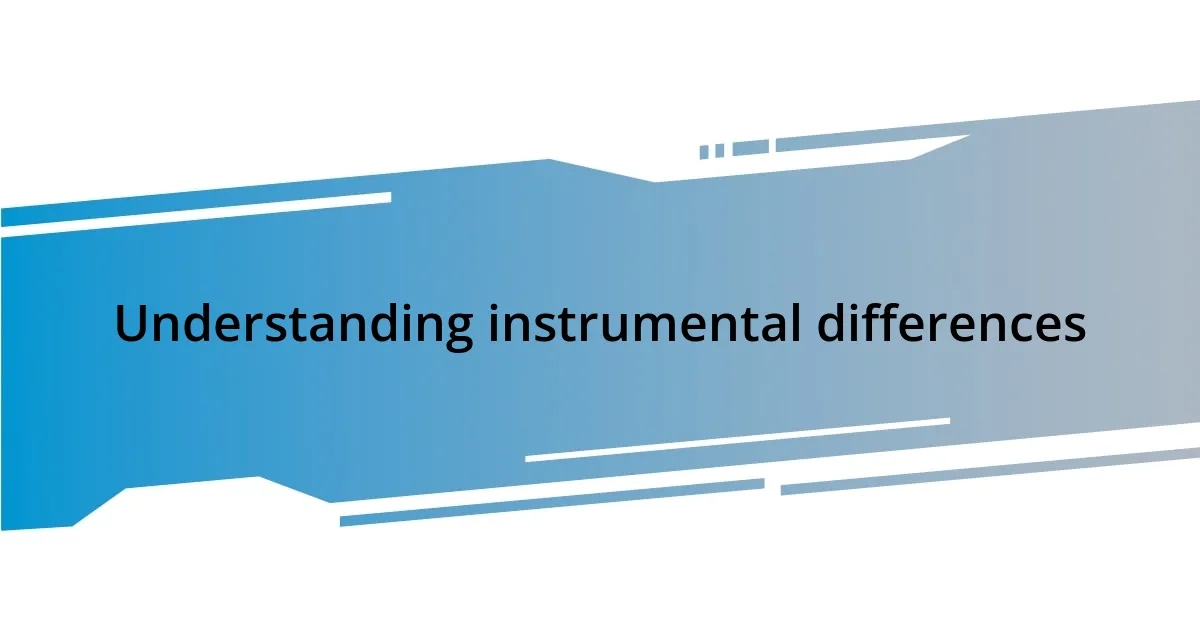
Understanding instrumental differences
Understanding different instruments is essential in the process of adapting music. Each instrument has its own timbre, range, and techniques that define its sound. For instance, the expressive capabilities of a violin allow for a nuanced interpretation of melodic lines, while a brass instrument might require a more robust sound to carry the same melody. As I explored these differences, it became clear how vital it is to consider not just the notes, but also the emotion behind them.
When I adapted a piece for clarinet after originally arranging it for flute, I was amazed at how the clarinet’s warm, rich tones added a new depth to the music. It felt like taking a familiar story and telling it with a different perspective, making me realize that adaptability goes beyond skill; it’s also about feeling the essence of each instrument. This experience taught me to listen intently, to understand how each instrument interprets music uniquely.
In my work, I’ve found that harmonies can sound entirely different based on the instruments involved. The lush sound of a piano can create full-bodied chords, while a guitar arrangement requires more careful selection of notes to fill the same harmonic space. Adapting a piece for different ensembles demands not just technical adjustments, but also an emotional connection to the music. Have you ever caught yourself feeling differently about a piece depending on the performers? This is precisely what I strive to achieve in my arrangements, creating a dynamic interplay that respects each instrument’s character.
| Instrument | Timbre |
|---|---|
| Violin | Bright and expressive |
| Clarinet | Warm and rich |
| Piano | Full-bodied and resonant |
| Guitar | Bright and chordal |

Choosing the right instrumentation
When it comes to choosing the right instrumentation, I’ve discovered that understanding the piece and its intention is foundational. I often reflect on a project where I worked on a vibrant folk tune initially arranged for solo piano. When I decided to bring in a mandolin, the lively plucking and unique harmonic colors transformed the piece. It felt like breathing new life into the music. The excitement of experimenting with different instruments can often lead to surprising places where melodies take on a new character.
Here are some key considerations for choosing the right instrumentation:
- Purpose of the Piece: What emotion or message are you trying to convey?
- Instrument Strengths: Does the instrument naturally suit the piece’s style or energy?
- Ensemble Balance: How will different instruments interact, and can each voice be heard clearly?
- Technical Capabilities: Do the players have the skills required for the arrangement?
- Audience Engagement: Will the instrumentation captivate your intended listeners?
Through these considerations, I’ve learned to approach each adaptation with a sense of curiosity, eager to discover how an instrument can shape the music’s narrative.
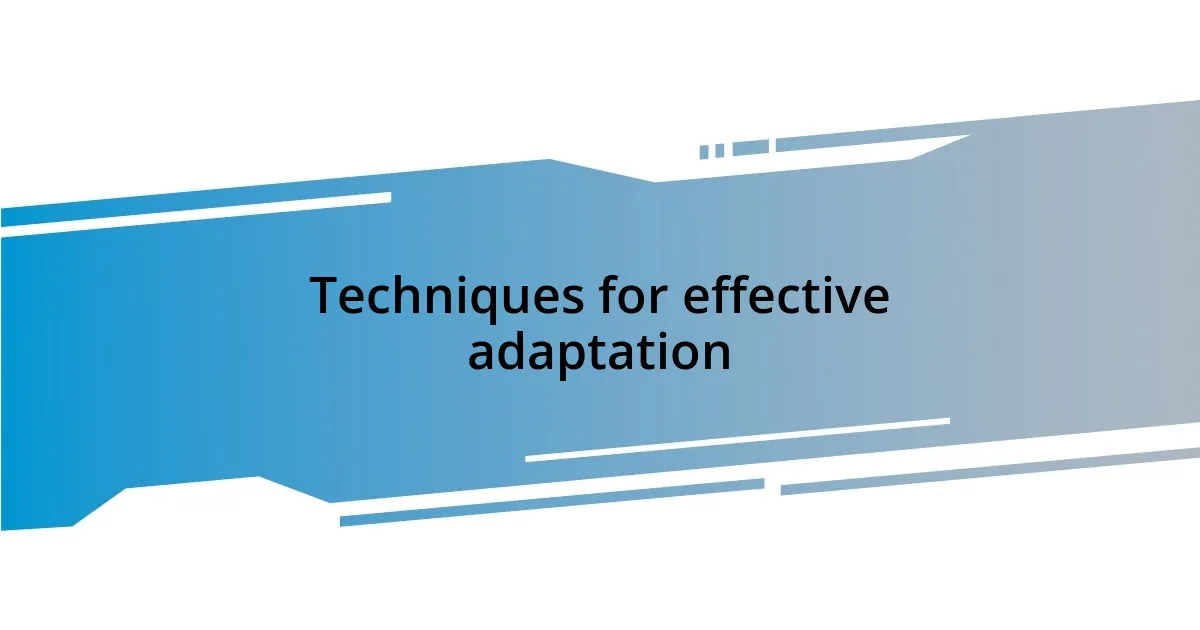
Techniques for effective adaptation
Adapting music for different instruments truly requires a keen ear and a willingness to experiment. I vividly recall the time I rearranged a jazz standard written for wind ensemble and decided to feature an electric guitar instead of a saxophone. The texture shifted considerably, as the guitar’s ability to bend notes brought a whole new emotional layer to the piece. Have you ever noticed how a single instrument can completely alter your perception of a melody?
One effective technique I often employ is creating variations in dynamics and articulation that cater to each instrument’s strengths. For instance, when I arranged a lively folk song for a string quartet, I emphasized bowing techniques like staccato and legato to exploit the strings’ expressiveness. This not only highlighted the unique qualities of each instrument but also maintained the energy of the original piece. It’s as if each note was dancing, and I couldn’t help but smile at how each player’s distinct voice blended into a beautifully cohesive sound.
I also find it essential to consider the emotional arc of the piece during adaptation. While working on a soulful ballad for cello, I focused on creating longer sustained notes that capitalized on the instrument’s dramatic resonance. It struck me how different colorations could evoke entirely different feelings. This led me to wonder—how does your mood influence the interpretation of the music you hear? Understanding this connection allows adaptability to go beyond technical choices, enriching the music’s narrative with depth and authenticity.
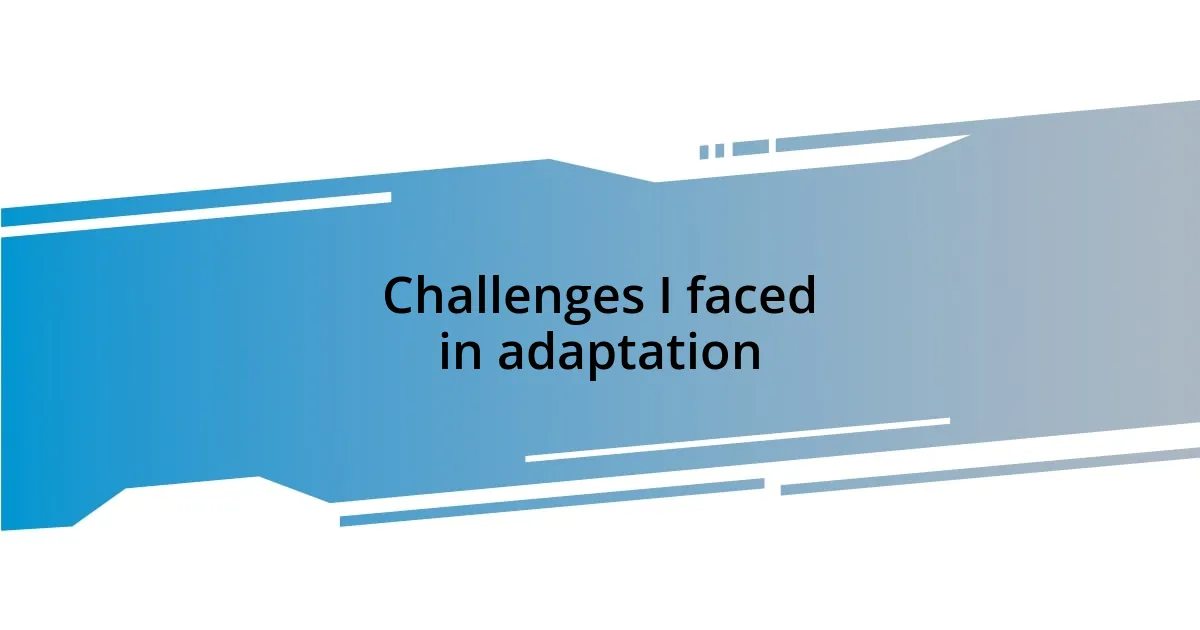
Challenges I faced in adaptation
Adapting works for different instruments hasn’t been without its hurdles. One significant challenge I faced was when I tried to arrange a classical piece for a bluegrass ensemble. The rhythmic feel was completely different, and I often found myself at a crossroads—how do I maintain the piece’s original integrity while making it resonate with a different musical genre? I remember the frustration of hearing a muddled sound that just didn’t capture what I had envisioned.
Another hurdle was understanding the technical limitations of certain instruments. I vividly recall a situation where I attempted to adapt a fast-paced jazz tune for a tuba. The rich, deep tones of the tuba were breathtaking, but they couldn’t deliver the piece’s brisk tempo. It hit me hard; not every instrument could handle the nuances I wanted to incorporate. Have you ever felt like an idea just wouldn’t translate no matter how hard you tried? This experience humbled me and shifted my focus towards writing parts that truly fit their instruments.
Lastly, engaging musicians’ personal styles posed another challenge. When I arranged a piece for a small chamber group, each player brought varied interpretations to the music, which sometimes clashed. It made me realize the importance of communication in collaboration. How can I create a cohesive sound without overshadowing individual artistry? This experience taught me the value of embracing each musician’s unique expression while also guiding us toward a unified vision. In overcoming these challenges, I found that adaptation is not just about rearranging notes—it’s about fostering a dialogue among the instruments.

Lessons learned from my experience
During my journey adapting works for different instruments, I’ve learned the importance of flexibility. I remember sitting down with a classic piano piece and feeling a rush of excitement when I decided to arrange it for marimba. As I translated the lush harmonies, I realized that the marimba brought a lightness to the music that I hadn’t expected. Have you ever stumbled upon a surprising revelation while working on a project? It reinforced that adaptability can often lead to delightful discoveries.
One lesson that hit home was about listening deeply to each instrument’s voice. While crafting a piece for a mixed ensemble, I paired a flute with a bassoon. I could have easily let the technical aspects dictate the arrangement, but instead, I tuned into their contrasting tones. The warm depth of the bassoon grounded the ethereal qualities of the flute, creating a captivating dialogue. It led me to ponder—how often do we really listen to the voices around us? This experience taught me that true adaptation comes from a profound understanding of how instruments express emotions differently.
Another valuable insight was the significance of feedback. I recall after completing an arrangement for a brass quintet, I sought the musicians’ input. They offered perspectives I hadn’t considered, from phrasing nuances to balance issues. It reminded me that collaboration isn’t just about the finished product; it’s about the journey of creation. Have you felt the thrill of watching an idea evolve through collaborative input? Engaging with fellow musicians allowed me to refine my work and embrace a richer creative process I hadn’t foreseen.


